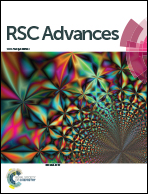A facile method of synthesizing ammonia modified graphene oxide for efficient removal of uranyl ions from aqueous medium
Abstract
Graphene oxide has recently emerged as an efficient adsorbent for removal of heavy metals including radionuclides from contaminated ground water. Here we demonstrate very high adsorption capacity (qe = 72.2 mg g−1) of graphene oxide for adsorption of uranyl ions. However, in the presence of common interfering cations (Ca2+, Mg2+, K+, Na+, Pb2+, Fe2+ and Zn2+) and anions (CO32−, HCO3−, Cl− and SO42−) that are expected in ground water, the adsorption capacity of uranyl ions on graphene oxide decreased drastically owing to poor selectivity. Here we also report a strategy for significantly improving selective adsorption of uranyl ions in the presence of the above interfering species. The graphene oxide is modified by liquid ammonia in the presence of a dehydrating agent (the material obtained is referred to as NH3-GO adsorbent) and thoroughly characterized by zeta potential measurement, Raman spectroscopy, Fourier transformed infrared spectroscopy, transmission electron microscopy and scanning electron microscopy. The suitability of NH3-GO as an adsorbent of uranyl ions has been studied in batch mode as a function of pH, temperature, adsorbent dose and initial concentration of uranyl ions. The maximum experimental adsorption capacity at equilibrium conditions is found to be 40.1 mg g−1 at pH 6 at 298 K, which is not affected by the presence of most of the cations and anions. This marked improvement in the selectivity of uranyl ion adsorption is attributed to amidation of graphene oxide, rendering improved selectivity as compared to carboxylic acid groups. The maximum monolayer coverage (qmax) was deduced as 80.13 mg g−1, indicating it to be an excellent adsorbent. The mechanism of adsorption is studied in terms of adsorption isotherm models, kinetic models and thermodynamic studies, which indicated a dual mechanism of chemisorption and physisorption owing to more than one type of binding site in NH3-GO. It is concluded that the ammonia modified graphene oxide exhibited a highly selective adsorption property for uranyl ions at neutral pH.


 Please wait while we load your content...
Please wait while we load your content...